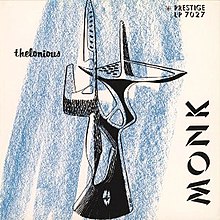Thelonious Monk Trio
| Thelonious Monk Trio | ||||
|---|---|---|---|---|
 |
||||
| Studio album by Thelonious Monk | ||||
| Released | 1954 | |||
| Recorded | October 15 and December 18, 1952; September 22, 1954 | |||
| Length | 34:55 | |||
| Label | Prestige | |||
| Thelonious Monk chronology | ||||
|
||||
| Professional ratings | |
|---|---|
| Retrospective reviews | |
| Review scores | |
| Source | Rating |
| AllMusic | |
| MSN Music | A+ |
| The Penguin Guide to Jazz | |
| The Rolling Stone Album Guide | |
| Rolling Stone Jazz Record Guide | |
| Sputnikmusic | 4.5/5 |
Thelonious Monk Trio is an album by American jazz pianist and composer Thelonious Monk. It was originally released in 1954 as Monk's first proper studio album and has been re-released numerous times, occasionally under the title Monk's Moods and with different track orders.
The album features his earliest recordings for the Prestige label performed with Gary Mapp [originally listed as "Gerry Mapp"] and Art Blakey or Max Roach, and one track with Percy Heath replacing Mapp. The album contains the earliest recorded versions of the jazz standards "Blue Monk" and "Bemsha Swing".
Thelonious Monk Trio was originally released in 1954 as Monk's first proper studio album. It follows the release of his two Genius of Modern Music compilations—the first volume in 1951 and the second volume in 1952. The record has since been re-released numerous times on different formats usually with its original title, although occasionally as Monk's Moods. On some of its re-releases, Thelonious Monk Trio had a track listing order different from the original, which opens with "Little Rootie Tootie". The album features the first recorded performances of "Blue Monk" and "Bemsha Swing".
Ronnie D. Lankford, Jr. of Allmusic called the album "intimate, intense, and inspired ... 35 minutes of professional musicians practicing their craft", and wrote that, although they were "pieced together from three different sessions," the recordings' "small settings ... allow the necessary space for Monk's explorations, which conjure up images of a mathematician working out geometric patterns on the keyboard."BBC Music's Charles de Ledesma commented that "the various personnel make little difference to the overall effect – Monk throughout offers a sumptious flow of melody, punctuation, nuance and charm."
Chris May of All About Jazz dubbed Thelonious Monk Trio "immortal, stratospheric music ... amongst the most eternal of his albums" and stated, "At this period like no other, Monk's rhythmic attack packed the power of an express train."Sputnikmusic's Alex Robertson said that "even when Monk gets nutty, as on the brutally virtuosic 'Trinkle, Tinkle,' the album's appeal lies not in his 'sabotage' of popular music but his ability to turn it into something invigoratingly weird, two approaches often conflated when looking back on the work of an inventive musician." In MSN Music, Robert Christgau said the record offers "the not so common chance to hear Monk as a solely featured soloist with a rhythm section", with drummers Art Blakey and Max Roach performing like "co-stars".
...
Wikipedia
